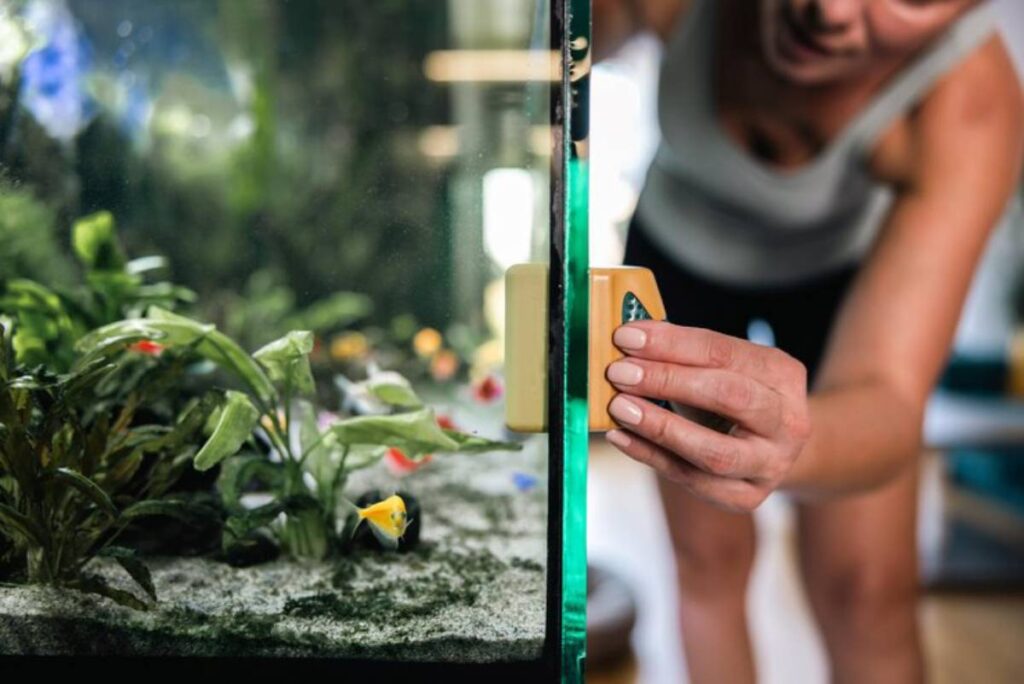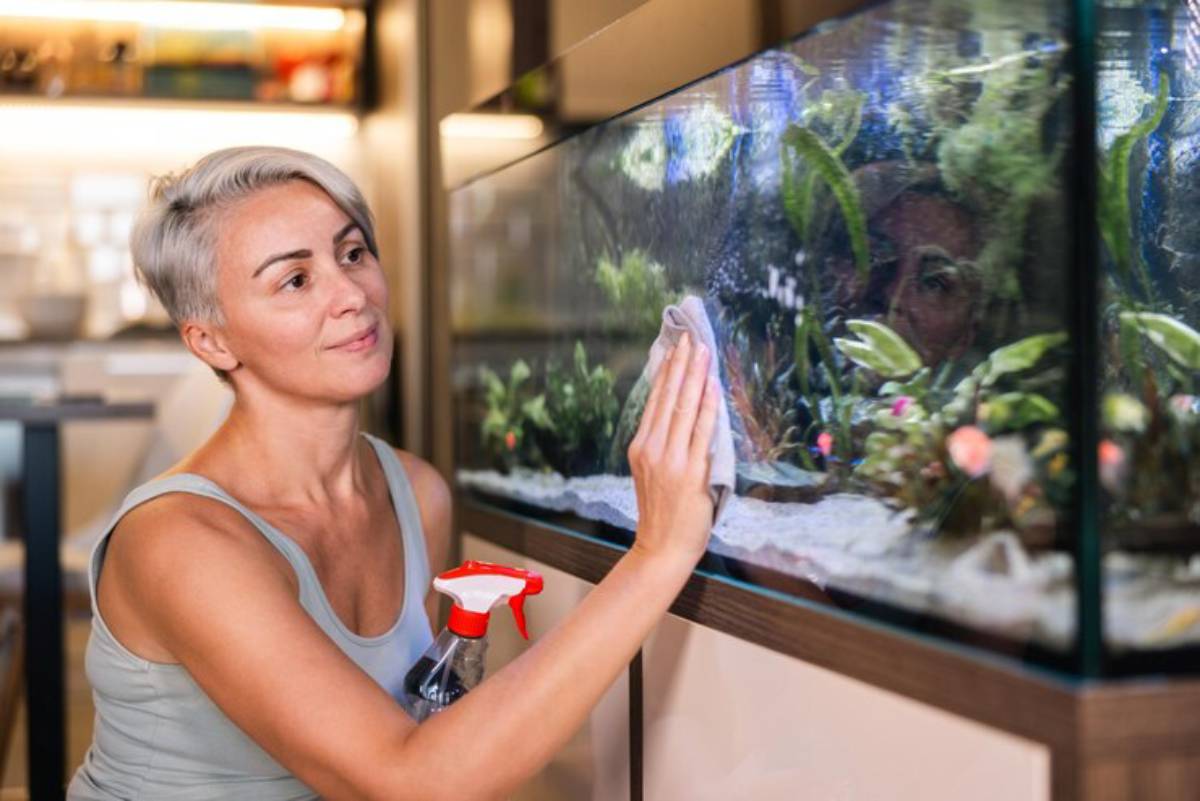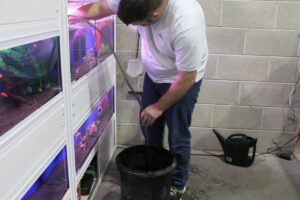The Pets Care Blog

Safe Cleaning Tools for Fish Tanks: How to Clean Without Stressing Your Aquatic Pets
Keeping your aquarium clean isn’t just about making it look nice — it’s about creating a stable, healthy environment for your fish to thrive. But there’s a fine line between effective cleaning and stressing out your aquatic pets. The key? Using the right tools.
Not all cleaning gear is designed with fish safety in mind. Harsh materials, strong chemicals, and poor design can harm your tank’s ecosystem. They might even hurt your fish. That’s why it’s essential to choose fish-safe cleaning tools that are gentle on your tank while still getting the job done.
In this guide, we’ll explore the must-have aquarium cleaning tools for every type of tank, what to avoid, and how to clean your tank safely, without risking the health of your aquatic friends.
Why Safe Cleaning Tools Matter
Fish are sensitive creatures. Sudden movement, rough materials, or chemical residues can affect their gills, scales, and stress levels.
Unsafe Cleaning Can Lead To:
- Physical injury to fish from sharp or abrasive tools
- Disruption of beneficial bacteria colonies
- Chemical contamination
- Unnecessary stress leading to illness or death
- Damaged equipment or tank décor
Using the right fish-safe cleaning gear ensures that your weekly and monthly maintenance routines protect your fish and make your life easier.
Essential Aquarium Cleaning Tools (and How to Use Them Safely)
Let’s break down the cleaning process into parts glass, substrate, décor, and equipment. Each area requires different tools and a little know-how.
1. Algae Scrapers and Magnetic Glass Cleaners
Algae is a natural part of any aquarium, but it can quickly cloud your view or overwhelm your glass.
Best Tools:
- Magnetic cleaners for daily or weekly use
- Plastic blade scrapers for stubborn algae
- Algae pads made specifically for aquarium glass (not household sponges)
What to Avoid:
- Steel wool or kitchen scourers — too abrasive
- Soap or chemical cleaners — toxic to fish
- Scrapers with exposed metal edges
Always test a scraper on a small corner first. Acrylic tanks scratch easily — use acrylic-safe tools only.
2. Gravel Vacuums and Siphons
Debris settles in your substrate quickly — uneaten food, fish waste, and decaying plants. A gravel vacuum helps remove this without tearing up your tank.
Recommended Options:
- Manual siphon vacuums (best for beginners)
- Battery-powered vacs for hands-free cleaning
- Python water changers for large tanks
Safe Use Tips:
- Don’t over-stir the gravel — you might disturb beneficial bacteria
- Vacuum a different section of the substrate each week
- Avoid suctioning too close to small or bottom-dwelling fish
Need help building a routine? Pair your vacuuming with this weekly aquarium maintenance checklist to stay on track.
3. Aquarium Brushes for Décor and Equipment

Ornaments, driftwood, and rocks can collect grime and algae too. You’ll need brushes with flexibility and fish-safe materials.
Best Brushes:
- Soft-bristle toothbrushes (designated for aquarium use only)
- Tube brushes for filter hoses
- Detailing brushes with rubber or nylon bristles
What to Avoid:
- Hard plastic or wire bristles
- Harsh scrubbing — especially on natural décor like driftwood
- Cleaning agents (even vinegar), unless rinsed extremely well
If your tank includes live plants or intricate décor, check out arranging décor for fish safety and aesthetics for layout ideas that simplify cleaning.
4. Aquarium-Safe Buckets and Containers
You’ll need dedicated buckets for water changes and rinsing filter parts. Avoid reusing cleaning buckets or food-grade containers with soap residues.
Bucket Best Practices
- Label your aquarium bucket clearly
- Use only for fish tank tasks
- Rinse well before each use
- Store away from bleach or household chemicals
Even small traces of soap or detergent can be deadly to fish.
5. Tongs or Grabbers for Safe Handling
Need to adjust décor or remove debris without submerging your arm? Use aquarium tongs or grabbers. These keep oils and residues from your hands out of the tank.
Features to Look For
- Rustproof stainless steel or silicone tips
- Long handles (30–60 cm)
- Soft grip ends that won’t damage plants or disturb substrate
6. Cleaning Cloths and Towels

You’ll need towels to wipe up spills, dry equipment, and keep your station clean.
Aquarium-Safe Options
- Microfibre cloths for outside glass
- Lint-free cotton towels for drying tools
- Paper towels (unscented) for fast clean-up
Never use cleaning sprays on or near your tank. Even glass cleaner mist can harm aquatic life.
Optional But Helpful Tools
As you gain experience, you might add more tools to your cleaning kit
- Filter floss for spot-cleaning cloudy water
- Aquarium tongs for planting
- Aquarium gloves to protect your skin from sharp décor or irritation
- UV steriliser to reduce algae and pathogens (not essential, but useful)
Cleaning Tool Storage Tips
- Rinse all tools with clean, dechlorinated water after each use
- Air dry thoroughly to prevent mould or corrosion
- Store separately from household cleaning products
- Keep everything in a labelled caddy or basket for easy access
What About Chemical Cleaners?
Short answer Avoid them entirely unless absolutely necessary. Most cleaning tasks can be done with elbow grease and tank-safe tools.
If you must sanitise (e.g., after illness or a tank reset), use
- White vinegar for soaking (rinse very thoroughly)
- Hydrogen peroxide dips for algae on décor (careful dosage)
- Bleach solution (1:20) for non-porous items — only with multiple rinse cycles and dechlorinator soak
Always dry thoroughly and allow items to air out before returning them to the tank.
Summary: Safe Tank Cleaning in Practice
A sparkling aquarium is a delight to see. It also shows that your fish live in a healthy environment. With the right tools and techniques, you can clean confidently. This way, you won’t disrupt the delicate balance of your underwater world.
Weekly Essentials:
- Algae scraper or magnetic cleaner
- Gravel vacuum
- Fish-safe brushes
- Bucket just for aquarium use
- Thermometer and visual inspection
Monthly or As-Needed Tools:
- Filter hose brushes
- Tongs or tweezers
- Cleaning cloths and gloves
Conclusion: Gentle Tools, Healthy Fish
Keeping a clean tank isn’t just about scrubbing it. It’s more about using fish-safe cleaning tools. This way, you protect your pets and maintain a healthy environment.
Think of your cleaning kit as an aquarium first-aid box built for safety, consistency, and care. With the right tools and a bit of weekly effort, your tank can shine — and your fish can thrive — for years to come.
So here’s your next step: Audit your cleaning gear. Replace any worn or unsafe tools and create a dedicated space for your aquarium toolkit. Your fish will feel the difference — and so will you.









